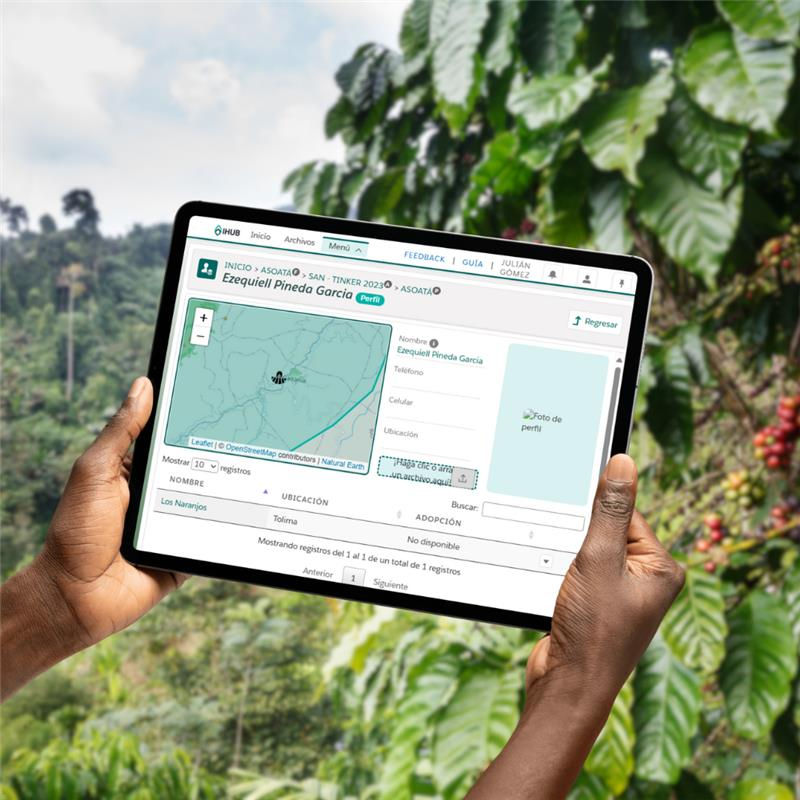Digital and community tools: SAN’s solutions to adapt to the EUDR
- Communications

- Aug 22
- 3 min read
In the wake of the European Union Deforestation Regulation (EUDR), SAN has had the chance to showcase the collective power of 20 years of experience in sustainability innovation. Not only the network has members working in all impacted commodities, but several experiences have prepared the SAN technical team to provide support in traceability and international standards. One of them is SAN’s Intelligence Hub (iHub).

Designed to be a powerful information management system that helps producers and other actors in regenerative agriculture food supply chains simplify decision making processes, the iHub has evolved over the course of a decade: from the ambitious idea of a customizable product capable of helping member organizations benchmark sustainability standards, to calculating carbon emissions, generating visual reports, and more.
One of the earliest features in the iHub was the evaluation tool with offline capabilities, designed to assess the performance of a farm under any standard or sustainability scheme. Faced with the implementation of the EUDR, it was only logical that the tool could be customized to include the specific monitoring and verification standards set by the new regulation. To prepare for this, SAN partnered its member organization Preferred by Nature to incorporate their Sustainability Framework —which has been aligned with the EUDR requirements— to the app, as a tool to aid sectors in achieving compliance.
In previous experiences, SAN had utilized the adoption observations methodology and proxies to determine compliance with specific regulation. The resulting indicators were integrated as subsets of the Sustainability Framework to create a tool to aid sectors in achieving compliance. Thus, the iHub has repeatedly demonstrated its capacity to offer organizations a flexible and single source of truth for their agricultural operations, simplifying compliance, streamlining reporting, and amplifying impact across entire supply chains.
"The iHub represents our commitment to continuous innovation— we've designed and architected it as a living platform that anticipates and responds to shifting market and compliance demands, because we are combining the specific agricultural knowledge of SAN with the specialized technical know-how of an in-house developing team", explained Enzo Jimenez, SAN's Senior Manager for Data Science, and Technological Innovation.
"Unlike generic data platforms retrofitted for agriculture, the iHub was born in the field and built for complexity—offering unlimited flexibility to incorporate multiple certification schemes, custom indicators, and tailored dashboards that speak directly to each organization's unique needs."
Community Monitoring, a collective push for excellence
At the same time as the EUDR was being enacted, SAN and Fundación Natura were piloting the Community-based Monitoring and Assurance System (CMAS), a project aimed at leveling the playing field on which smallholders compete with large producers to access sustainable markets.
By empowering smallholders to do their own monitoring and to record it collectively as a community –rather than as individual farmers—the CMAS fostered spaces in which not only expensive third-party accreditations were no longer necessary, but the data was owned by the collective, and decisions could be made at a community level.

While this was designed for and tested with coffee producers, the successful experience can be tailored to other commodities. The mapping capabilities of the iHub, combined with ODK integration for offline connection, have been particularly useful to draw the farm limits for the due diligence systems required by the European Union.
"Through platform interfaces and integrations, the iHub is connected to sources such as Global Forest Watch, and meteorological services. When cross-referenced with geolocation data and polygons, users can access enriched data that can be used to better plan for farm management”, added Jimenez.
What’s next?
Looking to the future, SAN’s development team is exploring the integration of blockchain technology to safeguard product traceability and transparency from farm to market. The vision is to equip users with a unified platform, enabling seamless reporting that meets EUDR requirements through an immutable data pipeline. Ultimately, the goal is to ensure that the iHub delivers robust technical assurance of sustainability across entire value chains—even extending its reach to commodities beyond those covered by the current regulation.



Comments